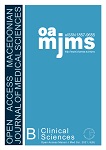Midkine as an Early Biomarker of Contrast-induced Acute Kidney Injury in Chronic Kidney Disease Patients Undergoing Percutaneous Coronary Intervention for Acute Coronary Syndrome: A Single-center Prospective Study
DOI:
https://doi.org/10.3889/oamjms.2021.6634Keywords:
Contrast-induced nephropathy, Acute kidney injury, Chronic kidney disease, Percutaneous coronary intervention, MidkineAbstract
Background: Contrast-induced acute kidney injury (CI-AKI), is an important complication of percutaneous coronary intervention (PCI). We aimed to study the role of serum midkine (MK) as an early biomarker of CI-AKI.
Methods: We conducted a prospective observational cohort study. It includes 100 chronic kidney disease (CKD) patients with an estimated glomerular filtration rate (eGFR) <60 ml/min/1.73m2. All patients were undergoing PCI for ACS. We measured serum midkine before, 2 and 24 hours after PCI.
Results: The mean age of the patients was 70.32±3.62 years, 74% males. Twenty-seven patients developed CI-AKI. The CI-AKI group has a history of diabetes mellitus (DM) and/or dyslipidemia, history of diuretics, metformin and/or angiotensin-converting enzyme inhibitors/angiotensin-receptor blockers (ACEI/ARBs) use. The CI-AKI patients have low left ventricular ejection fraction (LVEF) (EF < 45%) and low Creatinine Clearance (CrCl) before PCI. The CI-AKI received more contrast volume, had a longer duration of PCI and had high Mehran risk score after PCI. Comparison between the two studied groups regarding serum MK showed that there was a statistically significant difference regarding serum MK 2 hours after PCI. Receiver operating characteristic (ROC) curve analysis for serum MK showed that serum MK measured 2 hours after PCI was statistically significant to predict CI-AKI.
Conclusion: An early Serum MK after PCI can be used as an early predictor of CI-AKI in ACS patients.
Downloads
Metrics
Plum Analytics Artifact Widget Block
References
Rear R, Bell RM, Hausenloy DJ. Contrast-induced nephropathy following angiography and cardiac interventions. Heart. 2016;102(8):638-48. https://doi.org/10.1136/heartjnl-2014-306962 PMid:26857214 DOI: https://doi.org/10.1136/heartjnl-2014-306962
James MT, Samuel SM, Manning MA, Tonelli M, Ghali WA, Faris P, et al. Contrast-induced acute kidney injury and risk of adverse clinical outcomes after coronary angiography: A systematic review and meta-analysis. Circ Cardiovasc Interv. 2013;6(1):37-43. https://doi.org/10.1161/circinterventions.112.974493 PMid:23322741 DOI: https://doi.org/10.1161/CIRCINTERVENTIONS.112.974493
Andreucci M, Faga T, Riccio E, Sabbatini M, Pisani A, Michael A. The potential use of biomarkers in predicting contrast-induced acute kidney injury. Int J Nephrol Renovasc Dis. 2016;9:205-21. https://doi.org/10.2147/ijnrd.s105124 PMid:27672338 DOI: https://doi.org/10.2147/IJNRD.S105124
Kato K, Kosugi T, Sato W, Arata-Kawai H, Ozaki T, Tsuboi N, et al. Growth factor Midkine is involved in the pathogenesis of renal injury induced by protein overload containing endotoxin. Clin Exp Nephrol. 2011;15(3):346-54. https://doi.org/10.1007/ s10157-011-0408-2 PMid:21360016 DOI: https://doi.org/10.1007/s10157-011-0408-2
Malyszko J, Bachorzewska-Gajewska H, Koc-Zorawska E, Malyszko JS, Kobus G, Dobrzycki S. Midkine: A novel and early biomarker of contrast-induced acute kidney injury in patients undergoing percutaneous coronary interventions. Biomed Res Int. 2015;2015:879509. https://doi.org/10.1155/2015/879509 PMid:25629054 DOI: https://doi.org/10.1155/2015/879509
Tsai TT, Patel UD, Chang TI, Kennedy KF, Masoudi FA, Matheny ME, et al. Contemporary incidence, predictors, and outcomes of acute kidney injury in patients undergoing percutaneous coronary interventions: Insights from the NCDR Cath-PCI registry. JACC Cardiovasc Interv. 2014;7(1):1-9. https://doi.org/10.1016/s0735-1097(12)60338-6 PMid:24456715 DOI: https://doi.org/10.1016/S0735-1097(12)60338-6
Watabe H, Sato A, Hoshi T, Takeyasu N, Abe D, Akiyama D, et al. Association of contrast-induced acute kidney injury with long-term cardiovascular events in acute coronary syndrome patients with chronic kidney disease undergoing emergent percutaneous coronary intervention. Int J Cardiol. 2014;174(1):57-63. https://doi.org/10.1016/j.ijcard.2014.03.146 PMid:24726211 DOI: https://doi.org/10.1016/j.ijcard.2014.03.146
Ji L, Su X, Qin W, Mi X, Liu F, Tang X, et al. Novel risk score of contrast-induced nephropathy after percutaneous coronary intervention. Nephrology (Carlton). 2015;20(8):544-51. https://doi.org/10.1111/nep.12429 PMid:25706048 DOI: https://doi.org/10.1111/nep.12429
Yuan Y, Qiu H, Hu XY, Luo T, Gao XJ, Zhao XY, et al. Risk factors of contrast-induced acute kidney injury in patients undergoing emergency percutaneous coronary intervention. Chin Med J (Engl). 2017;130(1):45-50. https://doi.org/10.4103/0366-6999.196578 PMid:28051022 DOI: https://doi.org/10.4103/0366-6999.196578
Uzunhasan I, Yildiz A, Arslan S, Abaci O, Kocas C, Kocas BB, et al. Contrast-induced acute kidney injury is associated with long-term adverse events in patients with acute coronary syndrome. Angiology. 2017;68(7):621-6. https://doi.org/10.1177/0003319716676173 PMid:28660805 DOI: https://doi.org/10.1177/0003319716676173
Celik O, Ozturk D, Akin F, Ayca B, Yalcın AA, Erturk M, et al. Association between contrast media volume-glomerular filtration rate ratio and contrast-induced acute kidney injury after primary percutaneous coronary intervention. Angiology. 2015;66(6):519-24. https://doi.org/10.1177/0003319714542277 PMid:25005762 DOI: https://doi.org/10.1177/0003319714542277
Zaki T, Samir A, Rashid TM, Galal H, Samir W. Assessment of estimated GFR and clinical predictors of contrast-induced nephropathy among diabetic patients undergoing cardiac catheterization. Egypt Heart J. 2015;67(3):249-58. https://doi.org/10.1016/j.ehj.2014.07.001 DOI: https://doi.org/10.1016/j.ehj.2014.07.001
Narula A, Mehran R, Weisz G, Dangas GD, Yu J, Généreux P, et al. Contrast-induced acute kidney injury after primary percutaneous coronary intervention: Results from the HORIZONS-AMI substudy. Eur Heart J. 2014;35(23):1533-40. https://doi.org/10.1093/eurheartj/ehu063 PMid:24603308 DOI: https://doi.org/10.1093/eurheartj/ehu063
Centola M, Lucreziotti S, Salerno-Uriarte D, Sponzilli C, Ferrante G, Acquaviva R, et al. A comparison between two different definitions of contrast-induced acute kidney injury in patients with ST-segment elevation myocardial infarction undergoing primary percutaneous coronary intervention. Int J Cardiol. 2016;210:4-9. https://doi.org/10.1016/j.ijcard.2016.02.086 PMid:26921538 DOI: https://doi.org/10.1016/j.ijcard.2016.02.086
Kim JH, Yang JH, Choi SH, Song YB, Hahn JY, Choi JH, et al. Predictors of outcomes of contrast-induced acute kidney injury after percutaneous coronary intervention in patients with chronic kidney disease. Am J Cardiol. 2014;114(12):1830-5. https://doi.org/10.1016/j.amjcard.2014.09.022 PMid:25438909 DOI: https://doi.org/10.1016/j.amjcard.2014.09.022
Downloads
Published
How to Cite
Issue
Section
Categories
License
Copyright (c) 2020 Mohamed Ahmed, Gamal Hamed Ibrahim, Mahmoud Adel, Amira Ismail, Abdallah Almaghraby, Mahmoud Abdelnabi (Author)

This work is licensed under a Creative Commons Attribution-NonCommercial 4.0 International License.
http://creativecommons.org/licenses/by-nc/4.0








